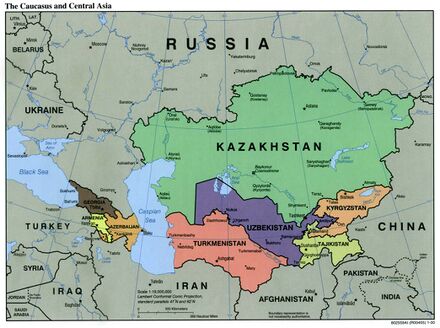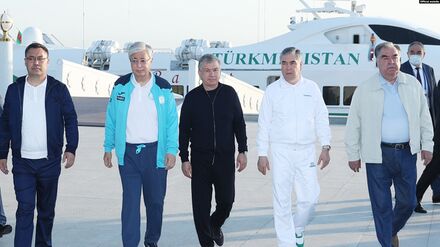Soviet Central Asia


Soviet Central Asia (советская центральная Азия или Средняя Азия) is region neat the central part of the Eurasian continent and also countries located in that area, characterized in that, than, during the USSR, these countries were declared to be part of the Soviet Union.
These countries are Kazakhstan, Uzbekistan, Kyrgyzstan, Turkmenistan and Tajikistan.
Etymology
Since the USSR (ventury 20) countries of the Soviet Central Asia keep the fascistic, autocratic, de-facto monarchy, regime of government of the Soviet style, with religious glorification of their life-time fuhrers, that justify word "Soviet" in the name.
As in century 21, as during the Soviet Union,
the countries of the Soviet Central Asia officially declare themselves as "republics", pretending to be democratic.
However, if any citizen or resident or even quest reveals,
indicates any violation of law by the administration in any of the Soviet Central Asia,
this caused new violation of law, id est, punishment, execution of the critics, who
date to declare something not approved by the country's fuhrer, "president", usurper.
De-facto, such a "president" act as if he should be owner of the country, and all the democratic institutes appears as a decoration, camouflage of the tyranny. In particular, such a "president" has the ability to modify the Constitution of his country as soon as he needs to justify his "reelection",
in order to remain as the life-time monarch.
Such a fascistic style of government also justifies using of word "Soviet" in the name.
For year 2021, the counties of the Soviet Central Asia are handled by
- Japarov Sadyr Nurgozhoevich (Жапаров Садыр Нургожоевич), Kyrgyzstan (Кыргызстан)
- Tokayev Kassym-Jomart Kemelevich (Токаев Касым-Жомарт Кемелевич), Kazakhstan (Казахстан)
- Shavkat Miromonovich Mirziyoyev (Мирзиёев Шавкат Миромонович), Usbekistan (Узбекистан)
- Berdimuhamedov Gurbanguly Malikguliyevich (Бердымухамедов Гурбангулы Мяликгулыевич), Turlmenistan (Туркменистан)
- Emomali Sharipovich Rakhmonov (Рахмонов Эмомали Шарипович), Tajikistan (Таджикистан)
In this order they are Shown in figure at right.
Caukazus
At the east from the Soviet Central Asia, across the lake Caspiian Sea, there are mounts Caykazus. The South part of Caukazus, including countries Georgia, Armenia and Azerbaijan is sometimes also considered as part of the Soviet Central Asia, but neither Dagestan, nor Chechnia, that, formally (at least until year 2022) are considered as part of Russia.
Countries of Caucasus are not so soviet as those of the Soviet Central Asia;
sometimes, the change of president in these republics happens at the relatively democratic procedure of the election, with relatively honest, prudent, correct counting of ballots, without murdering of the previous president and
without losing sovereignty.
In these sense, the countries of (Southern) Caucasus can be qualified as "republics";
so, allocation of specification "Soviet" to these republics is not justified.
Even Chechnia, due to its autocratic, monarchic political regime has more reasons to be qualified as "Soviet" than republics of the South Caukazus.
In TORI, term Soviet Central Asia is not applied to the Caucazus.
Georaphy
Countries of the Soviet Central Asia are located tropics. The climate there favoures varuious kinds of Agriculture.
In addition, at countries of the Soviet Central Asia, a lot of various mineral deposits are found, including the Uranium ore, coal, oil and gas.
One could expect the citizen of the Soviet Central Asia to be so rich as the Arabian emirates.
At least in the time interval since the coilonisation by the USSR to century 21, this does not happen; roughly, the half of total values in these countries belong to few hundred families of corrupted offees; they export capital to other countries and spent it for luxury.
For this common property, the special name Soviet Central Asia is required.
Channels of the collapse
The dictators at the Soviet Central Asia do not look to be very stable. Severlal channels of the collapse are discussed.
One of possible channel is war between relatives of the fuhrer. These relatives are very rich and occupy highest position in the administrative structure. The relation between the relatives of each monarch nay take various forms, from physical elimination (murdering) of the competitor (A la King Richard III) to collaboration, with division of the country between the powerful relative (A la King Lear), Распилить страну на родственников [2]. The last case may cause division of any or country of the Soviet Central Asia between relatives of the fuhrer Such a division, separation can be interpreted as continuation of collapse of the USSR – at least collapse of those countries, where the "president" has will and ability to eliminate all the constitutional forms of changing of the leader, becoming the monarch, the "life-time president", life-time "Elbasy".
Scientific interest
Case of the ex-soviet republics, fragments of the USSR, its fission products are interesting as examples of creation of civilization at ruins of the precious (more barmarian civilization).
Having started approximately at the same time, The colonies of Moscow's pahanat go in th pretty different ways.
The north-West countries (Estonia Latvia, Luthuania) go in the Western way: democracy, respect of the laws, separation of power, using the achievements of civilization for creation of new achievements. In these countries, in order to change the president and the government, for the people, it is sufficient to put mark at the specific place of the election ballots; no protests, no bloody riots are necessary to elect the new president.
Other products of the fission are less successful in construction of the capitalistic society; in certain sense, they remain Soviet. At Georgia and at Ukraine, the decommunization does not go so easy, and strong efforts are required to dismiss the usurper and to resist the aggression from the neighbor country (see Russian invasion into Georgia, Russian invasion into Ukraine, Russian invasion into Kazakhstan, Putin world war).
En fin, in some country, no any civilized way are seen to dismiss the "life-time president", usurper. This is case of the Soviet Central Asia. They keep the Soviet system of administration, based on slavery, misinformation (Propaganda), censorship and terror. Such a system allows the fuhrer to nominate his relatives and crime partners to all the key positions in the state administration. This leads to the total corruption. The usurper, the fuhred, through his offee, Handle the country as if it would be his own property. Usually, in such a case, all elements of fascism appear.
In such a way, countries of the Soviet Central Asia give good examples of formation of fascism and the degradation.
There is certain difference between some barbarian, inderdeveloped country, that goes in the way of civilization, and the country, that degrades to barbarian from something more civilized. In the last case, the barbarianism can be qualified as fascism: the society already know about cultural achievements of the human civilization (democracy, publicity, prudence, etc.) but intentionally reject them. In such a case, the duration of the fascistic society does not seem to be long; it is comparable to the lifetime of a human; often, the country collapses together with the fuhrer; and even faster, if the fuhrer removes the Separation of power from the federal law of his country. Intros case, the collapse of his political system occurs approximately within 16 years, see Kestus. This estimate appears in the primitive statiscilal model. It is important to analyze the range of applicability of this models.
Analysis of historic evolution of countries of the Soviet Central Asia may help to confirm, verify (see verification) or to reject, refute (see refutation) the model. For this analysis, the links about the Soviet Central Asia are collected in this article. They should help to see, how soon the republics convert from the "soviet" to something more civilized.
The existence of some historic mechanisms, that generate civilization from a barbarian society, is assumed. The evolution from the "soviet" to "civilized" is expected to reveal these mechanisms.
Warning
References
- ↑ https://rus.azattyq.org/a/central-asia-30-years-independence/31436344.html Брюс ПАННИЕР. 30 лет спустя. Зависимость независимых стран Центральной Азии 31 августа 2021, 12:56. Лидеры центральноазиатских государств на встрече в Авазе(слева направо): президент Кыргызстана Садыр Жапаров, президент Казахстана Касым-Жомарт Токаев, президент Узбекистана Шавкат Мирзиёев, президент Туркменистана Гурбангулы Бердымухамедов и президент Таджикистана Эмомали Рахмон // Три десятилетия назад, в 1991 году, центральноазиатские республики, входившие в состав Советского Союза, провозгласили независимость. Пять стран отметят юбилей на фоне признаков, свидетельствующих об усилении зависимости друг от друга. .. Все главы пяти республик были назначенцами Кремля.
- ↑ https://rus.azattyq.org/a/central-asia-states-rulers-and-their-sons-in-law/31161895.html Куанышбек КАРИ. «Распилить страну на родственников». Зятья президентов стран Центральной Азии. 25 марта 2021, 01:15. // Зятья президентов-долгожителей стран Центральной Азии часто становятся объектами внимания благодаря «удачливости» в бизнесе или занимаемым высоким постам на государственной службе. Эксперты говорят, что зятья способствуют развитию коррупции и непотизма в своих странах. Но их положение, как правило, весьма шаткое: стоит им оказаться в немилости, и они лишаются всего и сразу. .. когда авторитарный правитель приходит к власти, он старается установить свой контроль над всеми ключевыми отраслями страны. В этом деле он не может доверять «чужим», то есть кому-то вне его ближайшего окружения. Поэтому к управлению привлекаются все ближайшие родственники. ..
Keywords
Armenia, Azerbaijan, Berdimuhamedov Gurbanguly Malikguliyevich, Caukazus, Elbasy, Fascism, Georgia, Geography, History, Japarov Sadyr Nurgozhoevich, Kazakhstan, Mirziyoyev Shavkat Miromonovich, Kyrgyzstan, Pahanat, Rakhmonov Emomali Sharipovich, Russian invasion into Kazakhstan Tajikistan, Tokayev Kassym-Jomart Kemelevich Turkmenistan, Terror, USSR, Uzbekistan,